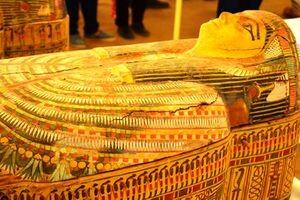In an archaeological breakthrough, researchers have uncovered a rare Middle Kingdom tomb in the South Asasif necropolis near Luxor, Egypt. This extraordinary discovery is the first tomb of its kind to emerge from this region, dating back nearly 4,000 years. The tomb harbors multiple burials and a treasure trove of artifacts that have lain undisturbed for millennia, offering an unprecedented glimpse into ancient Egyptian civilization.
The find was made during restoration efforts on the southern side of the tomb of Karabasken, a prominent official from the 25th Dynasty. Mohamed Ismail Khaled, head of the Supreme Council of Antiquities, underscored the significance of this discovery, noting that it not only alters historical perceptions of the Asasif necropolis but also elevates its status as a major Middle Kingdom cemetery.
“The tomb’s discovery provides fresh insights into Theban burial practices and rituals during the Middle Kingdom,” Khaled stated. “It enriches our understanding of ancient Egyptian culture and the evolution of their funerary traditions.”
Inside the tomb, archaeologists uncovered eleven burials believed to belong to a single family used over generations during the 12th and early 13th Dynasties. Despite ancient floods that ravaged wooden coffins and linen wrappings, durable materials like pottery and finely crafted jewelry survived, preserving the tomb’s historical narrative.
Hisham El-Leithy, who oversees Egyptian Antiquities Preservation, shared intriguing details about the artifacts. Among them were exquisitely crafted pieces of jewelry, including a unique necklace composed of 30 amethyst beads with two cylindrical agate beads framing a hippo-head amulet. Rings, bracelets, and chains made from red agate, blue and green faience, and stone adorned with animal-shaped amulets were also uncovered.
Catherine Blakeney, leader of the American archaeological team involved in the excavation, highlighted the discovery of two rare copper mirrors. One mirror features a handle designed with a lotus flower, while the other depicts the goddess Hathor, portrayed with a stern expression and four faces. Additional remarkable items include copper ingots, a small fertility figurine with intricately jeweled black-painted hair, and a square offering table adorned with motifs of a bull’s head, bread, and other offerings.
The team plans to persist in their excavations, eager to unravel more secrets of this ancient tomb. Their continued efforts promise to deepen our understanding of Egypt’s cultural and historical context during the Middle Kingdom, illuminating the lives and practices of its ancient inhabitants.
This series of discoveries not only paints a clearer picture of the past but also fuels curiosity and excitement about the secrets still buried beneath Egypt’s sands, waiting to be unveiled by the dedicated efforts of the archaeological community.



